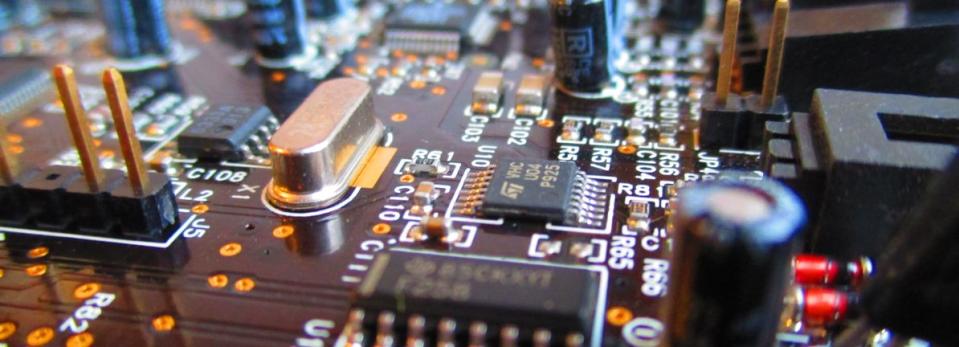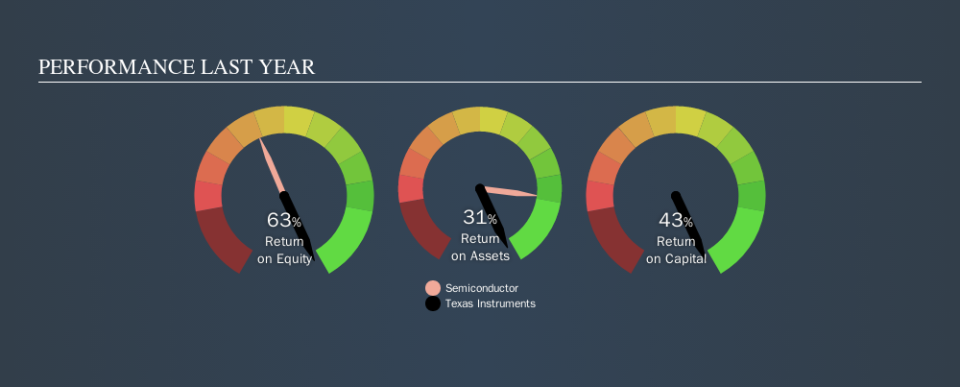Why You Should Like Texas Instruments Incorporated’s (NASDAQ:TXN) ROCE

Today we'll look at Texas Instruments Incorporated (NASDAQ:TXN) and reflect on its potential as an investment. In particular, we'll consider its Return On Capital Employed (ROCE), as that can give us insight into how profitably the company is able to employ capital in its business.
First of all, we'll work out how to calculate ROCE. Second, we'll look at its ROCE compared to similar companies. Last but not least, we'll look at what impact its current liabilities have on its ROCE.
Return On Capital Employed (ROCE): What is it?
ROCE measures the amount of pre-tax profits a company can generate from the capital employed in its business. Generally speaking a higher ROCE is better. Ultimately, it is a useful but imperfect metric. Renowned investment researcher Michael Mauboussin has suggested that a high ROCE can indicate that 'one dollar invested in the company generates value of more than one dollar'.
How Do You Calculate Return On Capital Employed?
Analysts use this formula to calculate return on capital employed:
Return on Capital Employed = Earnings Before Interest and Tax (EBIT) ÷ (Total Assets - Current Liabilities)
Or for Texas Instruments:
0.43 = US$6.3b ÷ (US$17b - US$2.6b) (Based on the trailing twelve months to June 2019.)
So, Texas Instruments has an ROCE of 43%.
View our latest analysis for Texas Instruments
Is Texas Instruments's ROCE Good?
When making comparisons between similar businesses, investors may find ROCE useful. In our analysis, Texas Instruments's ROCE is meaningfully higher than the 10% average in the Semiconductor industry. We would consider this a positive, as it suggests it is using capital more effectively than other similar companies. Putting aside its position relative to its industry for now, in absolute terms, Texas Instruments's ROCE is currently very good.
In our analysis, Texas Instruments's ROCE appears to be 43%, compared to 3 years ago, when its ROCE was 32%. This makes us wonder if the company is improving. You can see in the image below how Texas Instruments's ROCE compares to its industry. Click to see more on past growth.
When considering ROCE, bear in mind that it reflects the past and does not necessarily predict the future. ROCE can be deceptive for cyclical businesses, as returns can look incredible in boom times, and terribly low in downturns. This is because ROCE only looks at one year, instead of considering returns across a whole cycle. Since the future is so important for investors, you should check out our free report on analyst forecasts for Texas Instruments.
Do Texas Instruments's Current Liabilities Skew Its ROCE?
Current liabilities are short term bills and invoices that need to be paid in 12 months or less. The ROCE equation subtracts current liabilities from capital employed, so a company with a lot of current liabilities appears to have less capital employed, and a higher ROCE than otherwise. To check the impact of this, we calculate if a company has high current liabilities relative to its total assets.
Texas Instruments has total assets of US$17b and current liabilities of US$2.6b. As a result, its current liabilities are equal to approximately 15% of its total assets. This is quite a low level of current liabilities which would not greatly boost the already high ROCE.
Our Take On Texas Instruments's ROCE
, Texas Instruments looks strong on this analysis, but there are plenty of other companies that could be a good opportunity . Here is a free list of companies growing earnings rapidly.
For those who like to find winning investments this free list of growing companies with recent insider purchasing, could be just the ticket.
We aim to bring you long-term focused research analysis driven by fundamental data. Note that our analysis may not factor in the latest price-sensitive company announcements or qualitative material.
If you spot an error that warrants correction, please contact the editor at editorial-team@simplywallst.com. This article by Simply Wall St is general in nature. It does not constitute a recommendation to buy or sell any stock, and does not take account of your objectives, or your financial situation. Simply Wall St has no position in the stocks mentioned. Thank you for reading.

 Yahoo Finance
Yahoo Finance 
